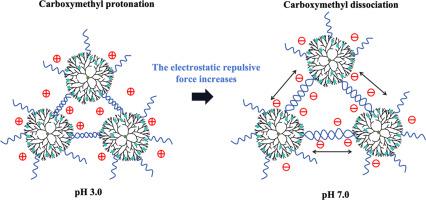Structural characterizations and potential delivery platform of glucan dendrimer-derived hydrogel
IF 12.5
1区 化学
Q1 CHEMISTRY, APPLIED
引用次数: 0
Abstract
In response to the challenge of lysozyme (LZM) inactivation in the acidic environment of gastric juice, a pH-responsive gel delivery system based on glucan dendrimer (PG) was developed to achieve targeted intestinal delivery and enhance its bioavailability. Initially, PG was carboxymethylated. Then, a three-dimensional glycosidic bond entanglement network was constructed through enzymatic assembly to prepare the CMPG gel carrier. The structural characteristics of this carrier were characterized using various techniques, such as SEM, FTIR, XRD, and rheological analysis. Additionally, enzymatic hydrolysis experiments were carried out to elucidate the digestion characteristics of PG (or CMPG)-Gel. Subsequently, an in vitro simulated digestion model was employed to evaluate both the release behavior and activity retention rate of LZM under conditions mimicking gastric juice (pH 1.2) and intestinal fluid (pH 7.4). Within two hours in an intestinal environment, the release rate was reached up to 87.51 %, while the structural integrity of LZM was ensured to remain intact. This study represented a novel approach in which PG was utilized as a gel carrier through dual modifications involving carboxymethylation and enzymatic assembly for the first time. Targeted drug release was successfully achieved by leveraging pH responsiveness.

葡聚糖树突衍生水凝胶的结构表征及潜在递送平台
针对胃液酸性环境中溶菌酶(LZM)失活的挑战,开发了一种基于葡聚糖树突状物(PG)的ph响应凝胶递送系统,以实现肠道靶向递送并提高其生物利用度。最初,PG被羧甲基化。然后,通过酶组装构建三维糖苷键缠结网络,制备CMPG凝胶载体。采用SEM、FTIR、XRD、流变学分析等方法对该载体的结构特征进行了表征。此外,还进行了酶解实验来阐明PG(或CMPG)-Gel的消化特性。随后,采用体外模拟消化模型,在模拟胃液(pH 1.2)和肠液(pH 7.4)条件下,评价LZM的释放行为和活性保留率。在肠道环境中,2小时内释放率高达87.51%,同时保证了LZM的结构完整性。本研究首次利用PG作为凝胶载体,通过羧基甲基化和酶组装的双重修饰。通过利用pH响应性,成功地实现了靶向药物释放。
本文章由计算机程序翻译,如有差异,请以英文原文为准。
求助全文
约1分钟内获得全文
求助全文
来源期刊

Carbohydrate Polymers
化学-高分子科学
CiteScore
22.40
自引率
8.00%
发文量
1286
审稿时长
47 days
期刊介绍:
Carbohydrate Polymers stands as a prominent journal in the glycoscience field, dedicated to exploring and harnessing the potential of polysaccharides with applications spanning bioenergy, bioplastics, biomaterials, biorefining, chemistry, drug delivery, food, health, nanotechnology, packaging, paper, pharmaceuticals, medicine, oil recovery, textiles, tissue engineering, wood, and various aspects of glycoscience.
The journal emphasizes the central role of well-characterized carbohydrate polymers, highlighting their significance as the primary focus rather than a peripheral topic. Each paper must prominently feature at least one named carbohydrate polymer, evident in both citation and title, with a commitment to innovative research that advances scientific knowledge.
 求助内容:
求助内容: 应助结果提醒方式:
应助结果提醒方式:


